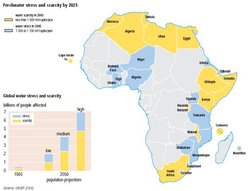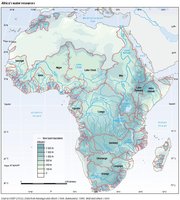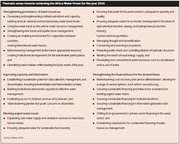Freshwater resources in Africa
The availability of and access to freshwater is an important determinant of patterns of economic growth (Economic change in Africa) and social development. This is particularly the case in Africa where most people live in rural areas and are still heavily dependent on agriculture (Agriculture and development in Africa) for their livelihoods. Water is an essential resource for sustaining economic development in all sectors. Freshwater is a necessary input for industry and mining, hydropower generation, tourism, subsistence and commercial agriculture, fisheries and livestock production. These activities are central to livelihoods and human well-being; they provide employment and contribute to national economies through, among other things, export earnings.
Water is not only an economic good but also a social good. Safe water (Society and water resources) supply and appropriate sanitation are the most essential components for a healthy and prosperous life. The provision of safe drinking water and adequate sanitation facilities, to the rural and rapidly expanding urban populations, can reduce mortality rates related to water-borne and water-related diseases, such as cholera, diarrhoea and malaria.

(Source: UNEP 2002)
Economic security and human well-being are dependent on the protection of this resource. This demands that water be managed as part of a healthy functional ecosystem, in order to ensure it continues to deliver essential environmental goods-and-services. The hydrological cycle links the different components of the environment (atmospheric (Atmospheric resources in Africa), marine (Marine ecosystem services), aquatic, terrestrial and subterranean), and this means that water resources are linked, via the water itself, to all the other components of the broader environment. This has important implications for management (Improving freshwater management in Africa) choices: integrated water resource management (IWRM) approaches ensure that water resources are managed as ecosystems. Further, the transboundary nature of water means that regional and sub-regional cooperation are essential to ensure the beneficial and sustainable use of this resource.
Africa is endowed with immense renewable natural resources including freshwater resources. Yet, natural phenomena, such as rainfall patterns and climate change (Causes of climate change) and variability, and human factors, such as population growth, competition over water, and pollution, increasingly threaten the sustainability of resources, and hence the livelihoods of many, particularly poor, people. It is widely recognized that a radical change in approach is required in order to adequately address these threats and so that the available water resources do not become a constraint, but serve as an instrument for accomplishing New Partnership for Africa’s Development (NEPAD) development goals. These goals include poverty alleviation, economic recovery and securing a sustainable environment. It is in this light that a shared Africa Water Vision (see Figure 1) and water supply and sanitation targets were defined at the World Water Forum in The Hague in 2000. The Vision calls for a new way of thinking about water and a new form of regional cooperation. It aspires to "An Africa where there is an equitable and sustainable use and management (Improving freshwater management in Africa) of water resources for poverty alleviation, socioeconomic development, regional cooperation, and the environment" and specific targets have been set. Achieving this Vision requires new approaches to governance and institutions, including, among other things, the adoption of integrated and participatory approaches, management at the lowest possible level and the mainstreaming of gender issues.
Overview of resources Figure 3: Renewable water resources (Source: AQUASTAT (Freshwater resources in Africa) 2003)
Africa’s extreme variability of rainfall – in time and space – is reflected in an uneven distribution of surface and groundwater resources, from areas of severe aridity with limited freshwater resources like the Sahara and Kalahari deserts in the northern and southern parts, to the tropical belt of mid-Africa with abundant freshwater resources.
Internal renewable freshwater resources average about 3,950 km3 per year (Figure 3). This amounts to about 10 percent of the freshwater resources available globally and closely resembles Africa’s share of the world population at 12 percent.

(Source: UNEP 2002, Revenga and others 1998, Rekacewicz 2996, Wolf and others 1999)
There are over 50 internationally shared river and lake basins in Africa. The map of Africa in Figure 4 shows the major river basins. These are the Niger, Lake Chad, Nile, Zambezi and Orange river basins. Most of the surface water resources are concentrated in the Congo, Niger, Ogooue, Zambezi and Nile. Less than 10 percent of Africa’s river and lake basins are covered by wetlands. Nevertheless, wetlands are an essential part of freshwater systems as they provide an array of environmental goods-and-services, such as flood and erosion control, water storage and filtering, a range of food and material products, as well as opportunities for recreation. Some basins, such as the Nile, Volta and Zambezi, have large dams (>60 meters high) for water supply and power generation. New dams are currently under construction in the Niger and Orange river basins. Compared with the last few decades, the rate of construction of new dams has greatly slowed down.
The urban population of Sub-Saharan Africa (SSA) is expanding at a rapid rate, and as a result there is a rise in demand for potable water (Society and water resources) supply. Groundwater can be a viable resource to meet growing demand provided the necessary protective and institutional measures are in place and enforced. Annual groundwater recharge per capita is lowest for Northern Africa: 144 m3 per capita for the Atlas Mountains and 350 m3 per capita for the North African basins; the extent of groundwater development in these parts is 49 percent and 22 percent of mean annual groundwater recharge respectively. In other sub-regions, annual groundwater recharge ranges from 2,400 to 9,900 m3 per capita.
Climate change and variability, population growth and increasing water demand, overexploitation and environmental degradation have significantly contributed to the worsening of the state of freshwater resources, leading to an increasing number of African countries where water demand outstrips available resources. Fourteen African countries experience water stress (less than 1,700 m3 per capita/year) or water scarcity (less than 1,000 m3 per capita/year). (see Figure 2).
Importance of water management
Developing appropriate policy and management systems is essential to enhance the value obtained from freshwater resources and to ensure its sustainability. This includes interventions to strengthen governance, improve knowledge and information systems including data collection and monitoring and evaluation, enhance human and institutional capacity, develop IWRM systems which focus on catchments and basins as the management unit, and mainstream gender. Cooperation and partnership, between multiple stakeholders and at multiple levels, from the local to the sub-regional to the regional, are at the core of successful interventions. These responses should improve the opportunities to meet urgent needs for potable water, sanitation, irrigation and hydropower, among others. A critical issue that will need to be addressed systematically is financing.
Further reading
- AQUASTAT
- Donkor, S. M. K., 2003. Development Challenges of Water Resource Management in Africa. African Water Journal, December 2003, Pilot Edition, 1-19.
- ECA, AU and AfDB, 2000. The Africa Water Vision for 2025: Equitable and Sustainable Use of Water for Socioeconomic Development. Economic Commission for Africa, African Union and African Development Bank. Addis Ababa.
- IGRAC, 2004. Global Groundwater Regions, version 25 May 2004. International Groundwater Resources Assessment Centre.
- IUCN, IWMI, Ramsar and WRI, 2003. Water Resources eAtlas, Watersheds of the World. IUCN-The World Conservation Union, the International Water Management Institute, the Ramsar Convention Bureau, and the World Resources Institute. World Resources Institute, Washington, D.C.
- MacKay, H., Ashton, P., Neal, M. and Weaver, A., 2004. Investment Strategy for the Cross-Cutting Domain: Water and the Environment. WRC Report No. KV 148/04. Water Research Commission, Pretoria.
- UNEP, 2006. Africa Environment Outlook 2
- WRI, UNDP, UNEP and World Bank, 2000. World Resources 2000-2001: People and Ecosystems - the Fraying Web of Life. World Resources Institute, Washington, D.C.
|
|
| Disclaimer: This article is taken wholly from, or contains information that was originally published by, the United Nations Environment Programme. Topic editors and authors for the Encyclopedia of Earth may have edited its content or added new information. The use of information from the United Nations Environment Programme should not be construed as support for or endorsement by that organization for any new information added by EoE personnel, or for any editing of the original content. |
